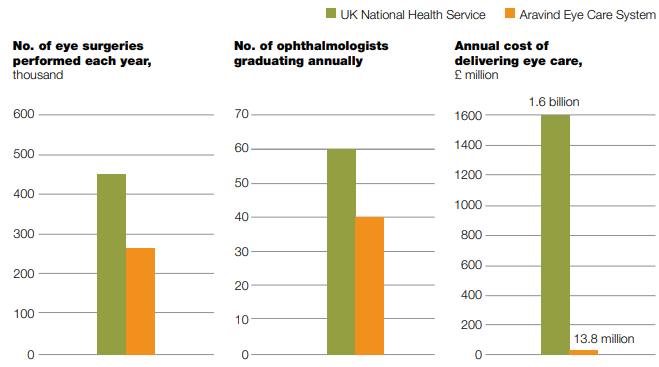Are you looking for scaling up your sales and revenue, by eliminating all the constraints that hardly allows you to perform. Tired of solving one constraint and see the next one is arriving shortly to hammer again. What if there is a valuable lesson that can be learned from a healthcare system which constantly drives to eliminate the constraint and make it as an opportunity to grow higher with passion and compassion.
In 1976, a retired ophthalmologist, Dr. G. Venkataswamy (better known as Dr. V.), then 58 years old, founded the Aravind Eye Hospital in Madurai (a bustling town of 3.5 million people in the southern state of Tamil Nadu, India) to address his mission of eradicating “needless” blindness in India and indeed all over the world.1 “High volume, high quality, and affordable cost” is the tri-part mantra of the Aravind model. Provide good service to enough people, and keep prices low and still make a profit.2
Today, while looking back the achievements done in the Aravind Eye Hospitals, One can easily find the relevance between the Theory of Constraints principles and its practical implementation. In Aravind, the landscape of eye care system was transformed by making it accessible, affordable and efficient for millions. Aravind embraced the principle of identifying and eliminating the constraints, wholeheartedly which enables them to be the pioneer in eye care industries. This article highlights the achievements done at Aravind based on the principles of Theory of Constraints.
Patients’ Affordability and Accessibility
Aravind faced initially the constraint on getting the rural patients to surgery. The rural eye camp provided them opportunity to screen the eye health of patients and give them the recommendation for immediate surgery (about 10 to 20 percentage) where required. The early surgery, could save from blindness. But, the people at rural India could not afford to travel to cities by leaving their day to day job and staying for few days as the cost of accommodation and food was not affordable to the poor community. Aravind realized this constraint, and came up with the model of arranging free transport to pick up, conducting surgery at free of charge, caring them for the short stay for few days and dropping them at home. This model supported them well in increasing the patients arrival. However Aravind offered a different price model to the people who can afford the price of a surgery, those who can’t it is completely free. Even, the transport model did not yield major results, unless they came up with local vision centers to cover the population of around 50,000 people as the people gets immediate attention rather waiting for a scheduled camp. These vision centers are connected to base hospital via video conferencing so that the patient would get immediate advice from the consulting doctor. About 91 percent of the patients seen in the vision centers are able to get the care they need.3 It is an example of using technology to leverage the constraint.
“Technology can bring benefits if and only if it diminishes a limitation.”
Dr. Eliyahu Goldratt
Surgery Capacity
Upon eliminating the first constraint, the capacity of surgical treatment exposed as another constraint that limits the entire flow of patients.
Dr. V. wanted to know, couldn’t the assembly-line efficiency that made hamburgers available on the street corners of every town in America, at a price everyone could afford, be harnessed to the mission of fighting blindness?
He took the example of McDonald’s operational excellence achievement and implemented it in this surgical operation. Where the doctors are performing the surgery of a patient, another patient get prepared next to them. The tools and other arrangements are made nearby them. Pre arrangements and post surgical arrangements are done by multiple nursing teams . The tables are designed flexibly to swing from one patient to next with microscope. Using this approach, Aravind able to complete minimum 6 to 8 surgeries in an hour.
Although, the productivity of surgical process improved exponentially, the health care quality always maintained equal to the developed countries.

In summarizing, Aravind Eye Hospital’s journey highlights the profound impact of implementing Theory of Constraints principles within healthcare and beyond. About 250+ hospitals worldwide adopted the learnings from Aravind. Aravind has reshaped the landscape of eye care, ensuring accessibility, affordability, and efficiency for millions. Aravind Eye Hospital’s enduring legacy stands as a testament to visionary leadership and unwavering dedication to excellence in service delivery.
FOOTNOTES
- Making Sight Affordable-Innovations Case Narrative: The Aravind Eye Care System by V. Kasturi Rangan and R.D. Thulasiraj ↩︎
- aravind.org ↩︎
- Driving Down the Cost of High Quality Care – Lessons from Aravind Eye Care System ↩︎
Leave a Reply